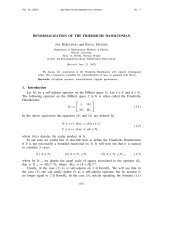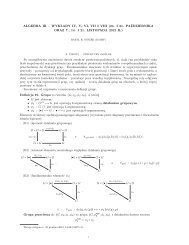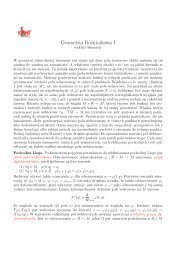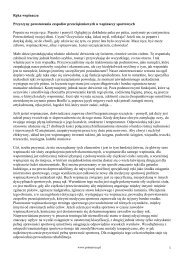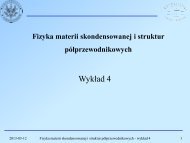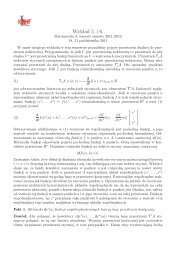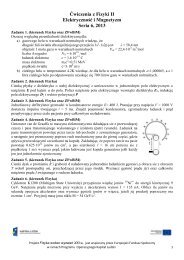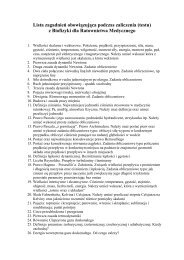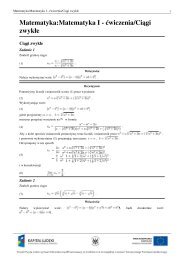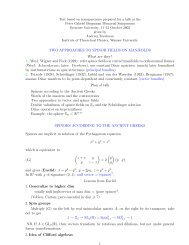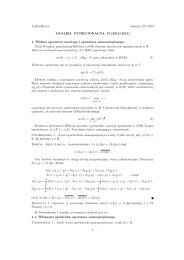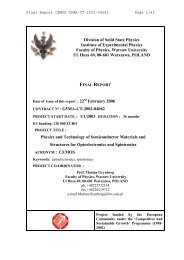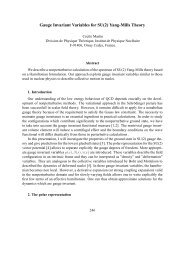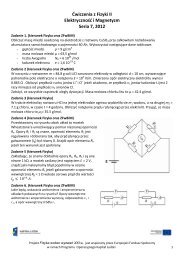XXth century_physics
XXth century_physics
XXth century_physics
Create successful ePaper yourself
Turn your PDF publications into a flip-book with our unique Google optimized e-Paper software.
Physics of the XX th <strong>century</strong><br />
Part 1
inward<br />
Atomic<br />
<strong>physics</strong><br />
outward<br />
Nuclear<br />
<strong>physics</strong><br />
Chemistry<br />
Condensed<br />
matter<br />
Particle<br />
<strong>physics</strong><br />
Reactors<br />
Astro<strong>physics</strong><br />
Accelerators<br />
Biology<br />
Plasma<br />
Transistors<br />
Physics<br />
of quarks<br />
Cancer<br />
therapy<br />
PET<br />
Isotopes<br />
Materials<br />
NMR<br />
Lasers<br />
Holography<br />
Spintronics<br />
Graphen<br />
~1915 ~1935 ~1975 ~2005<br />
?<br />
?<br />
?<br />
?
Physics of the atom<br />
and<br />
the path to quantum mechanics
Early atomic models<br />
1901 Jean Perrin atoms may look like<br />
miniature planetary systems<br />
1902 Kelvin negative electrons in atoms<br />
form groups inside a cloud<br />
of positive charge<br />
1903 Philipp Lenard atoms built of ‘dynamids’<br />
- pairs of electric charges<br />
1904 J. J. Thomson elaboration of qualitative<br />
Kelvin’s model<br />
‘plum pudding model’<br />
1904 Hantaro Nagaoka ‘Saturnian’ atom model
Hantaro Nagaoka<br />
Nagaoka's atomic model of 1904<br />
”The system , which I am going to discuss,<br />
consists of a large number of particles of<br />
equal mass arranged in a circle at equal<br />
angular intervals and repelling each other<br />
with forces inversely proportional to the<br />
square of distance; at the centre of the circle, place<br />
a particle of large mass attracting the other particles according to<br />
the same law of force. If these repelling particles be revolving with<br />
nearly the same velocity about the attracting centre, the system will<br />
generally remain stable, for small disturbances, provided the<br />
attracting force be sufficiently great... The present case will<br />
evidently be approximately realized if we replace these satellites by<br />
negative electrons and the attracting centre by a positively charged<br />
particle...”<br />
Phil. Phil.<br />
Mag. 7, , 445 (1904); Nature 69, 69,<br />
392 (1904)
Nagaoka’s Nagaoka s atomic model of 1904<br />
Hantaro Nagaoka<br />
The oscillations perpendicular to the plane of the electron<br />
ring were shown to lead to a spectrum having a band-like<br />
structure and the oscillations in the plane - to a kind of line<br />
spectrum. The α- and β-rays were emitted when the<br />
electron ring and the atomic nucleus broke up because of<br />
large disturbances.<br />
Phil. Mag. 7, 445 (1904)
Robert Millikan (1868-1953<br />
(1868 1953)<br />
Elementary charge e = 4.65 x 10 -10 electrostatic units<br />
measured by the oil-drop method [Phil. Mag. 19, 209 (1910)]
Important events in early atomic <strong>physics</strong><br />
1909 Geiger & Marsden - results on α scattering by thin foils<br />
1910 Haas - first atomic model containing Planck’s constant h<br />
1910 Thomson - theory of scattering in the ”plum pudding” model<br />
1911 Rutherford - nuclear atom model<br />
1913 Van den Broek - atomic number = nuclear charge Z<br />
1913 Van den Broek - nuclear electrons<br />
1913 Bohr - planetary atom model<br />
1913 Franck-Hertz experiment<br />
1913 Geiger & Marsden - confirmation of Rutherford’s theory<br />
1913 Moseley - frequencies of characteristic X radiation<br />
1913 Fajans, Soddy - displacement law for radioactive decays<br />
1913 Soddy - isotopes<br />
1914 Chadwick - continuous spectrum of electrons in β decay<br />
1916 Sommerfeld - extension of Bohr’s model<br />
1921 Stern-Gerlach experiment<br />
1922 Compton effect - scattering of X rays on free electrons<br />
1923 de Broglie - matter waves
Charles Glover Barkla (1877-1944) discovered<br />
characteristic X radiation of the elements<br />
Max von Laue (1979-1960)<br />
together with Walter Friedrich and Paul<br />
Knipping discovered diffraction of X-rays<br />
by crystals<br />
William Henry Bragg (1862-1942)<br />
William Lawrence Bragg (1890-1971)<br />
initiated the analysis of crystal<br />
structure by X-rays (Bragg formula<br />
for reflection)
Arthur Haas (1910)<br />
2a<br />
An electron moves on a circular orbit of radius r<br />
within a uniformly positively charged sphere of<br />
radius a. It experiences the force e2r/a r/a 3 . The<br />
maximum energy of the electron moving in an<br />
orbit of radius a equals the limiting frequency ν *<br />
of the Balmer spectrum multiplied by h<br />
hν * = e 2 /a<br />
If ν * is also the frequency of the electron in this orbit, then from the<br />
equilibrium of the Coulomb attraction e2 /a 2 and the centrifugal force<br />
4π2ν *2 *2mea a an equation follows<br />
h = 2π 2 |e|√√√√√√√√ mea which was found to be numerically satisfied<br />
[Called a ”carnival joke” in Vienna]
John William Nicholson (1911): atoms consist of small spheres<br />
of negative electricity rotating in a ring about a smaller sphere of<br />
positive electricity, the atomic nucleus. Vector sum of the<br />
accelerations of all the electrons rotating in the ring is zero. The<br />
simplest primary atoms are:<br />
Coronium Co mass 0.51282 2 electrons<br />
Hydrogen H mass 1.008 3 electrons<br />
Nebulium Nu mass 1.6281 4 electrons<br />
Protofluorine Pf mass 2.3615 5 electrons<br />
All known chemical atoms are composed of these primary atoms, e.g.<br />
Helium He = NuPf<br />
Uranium = 8{Nu 2(Pf H) 3 }4{He 2Nu 2(Pf H) 3}<br />
Nicholson found excellent agreement with measured values of atomic<br />
masses
By complicated reasoning Nicholson concluded that in all<br />
primary atoms the angular momentum assumed values which<br />
were integral multiples of h/2π. For protofluorine the ratio of the<br />
potential energy of the electron ring to the rotational frequency ν<br />
(5m e a 2 2πν 2) /ν equals numerically ≈ 25 h, and this ratio<br />
corresponded to 2π times the value of the angular momentum of<br />
the electron ring.<br />
”If, therefore, the constant h of Planck has, as Sommerfeld has<br />
suggested, an atomic significance, it may mean that the angular<br />
momentum of an atom can only rise or fall by discrete amounts<br />
when electrons leave or return. It is readily seen that this view<br />
presents less difficulty to the mind than the more usual<br />
interpretation, which is believed to involve an atomic constitution<br />
of the energy itself.”<br />
Nicholson (1912)
Accelerated electric<br />
charge radiates<br />
energy, hence atoms<br />
lose energy and<br />
cannot be stable
J. J. Thomson, On the Structure of the Atom:<br />
an Investigation of the Stability and Periods of Oscillation of<br />
a Number of Corpuscules arranged at equal Intervals around<br />
the Circumference of a Circle,<br />
Phil. Mag. 7, 237-265 (1904)<br />
Because of destructive interference the<br />
intensity of radiation by electric charges<br />
moving as a ring is reduced<br />
by many orders of magnitude;<br />
hence, atoms can be quasi-stable
Attenuation of radiation<br />
for rings of electrons<br />
circulating<br />
with v = 0.01 c<br />
4 1.7 10 -10<br />
5 5.6 10 -13<br />
6 1.6 10 -17
Solvay Conference 1911
Solvay Conference 1913
”...the instability of the central nucleus and the<br />
instability of the electronic distribution. The<br />
former type of instability leads to the expulsion<br />
of an α particle, the latter to the appearance of<br />
β and γ-rays...”<br />
Phil. Mag. 24, 453 (August 1912)
H. Geiger – On the Scattering of the α-Particles by Matter,<br />
Proc. Roy. Soc. 81, 174 (1908)<br />
A – vacuum<br />
B – one gold foil<br />
C – two gold foils
”One day Geiger came to me and said. 'Don't<br />
you think that young Marsden whom I am<br />
training in radioactive methods ought to begin<br />
a small research?' Now I had thought so too,<br />
so I said, 'Why not let him see if any<br />
alpha-particles can be scattered through a large angle?'<br />
The result was quite extraordinary.”<br />
Rutherford, Lecture in Cambridge (1936)
Proc. Roy. Soc. 82, 495 (1909)
"It was as though you had fired<br />
a fifteen-inch shell at a piece of tissue<br />
paper and it had bounced back and hit you."
In the ”plum-pudding” model of<br />
J. J. Thomson scattering of<br />
alpha-particles occurs<br />
predominantly at very small<br />
angles<br />
Scattering of alpha-particles at<br />
large angles gives evidence of<br />
the large central charge, the<br />
atomic nucleus (Rutherford<br />
model)
"I am beginning to think that the central core is<br />
negatively charged, for otherwise the law of<br />
absorption for beta rays would be very different<br />
from that observed...”<br />
Letter to William Henry Bragg, February 9, 1911<br />
"The scattering of the electrified particles is considered for<br />
a type of atom which consists of a central electric charge<br />
concentrated at a point and surrounded by a uniform spherical<br />
distribution of opposite electricity equal in amount."<br />
Abstract of a paper read before the Society on March 7, 1911.<br />
Proc. Manchester Literary and Philosophical Society, IV, 55, 18.
"Consider an atom which contains a charge ± Ne at<br />
its centre surrounded by a sphere of electrification<br />
containing ∓ Ne supposed uniformly distributed<br />
throughout a sphere of radius R... It will be shown<br />
that the main deductions from the theory are<br />
independent of whether the central charge is supposed to be<br />
positive or negative. For convenience, the sign will be assumed<br />
to be positive... It has not so far been found possible to obtain<br />
definite evidence to determine whether it be positive or<br />
negative..."<br />
Phil. Mag. 21, 669 (May 1911)<br />
"...I supposed that the atom consisted of a positively charged<br />
nucleus of small dimensions in which practically all the mass of<br />
the atom was concentrated. The nucleus was supposed to be<br />
surrounded by a distribution of electrons to make the atom<br />
electrically neutral, and extending to distances from the<br />
nucleus comparable with the ordinary accepted radius of the<br />
atom."<br />
Phil. Mag. 27, 488 (March 1914)
”Professor Rutherford has recently developed<br />
a theory to account for the scattering of α particles<br />
through these large angles, the assumption being<br />
that the deflexions are the result of an intimate<br />
encounter of an α particle with a single atom of the<br />
matter traversed. In this theory an atom is<br />
supposed to consist of a strong positive or negative central<br />
charge concentrated within a sphere of less than<br />
3 x 10 -12 cm radius, and surrounded by electricity of the opposite<br />
sign distributed throughout the remainder of the atom of about<br />
10 -8 cm radius.”<br />
Hans Geiger and Ernest Marsden,<br />
Phil. Mag. 25, 604 (1913)
”...considering the enormous variation in<br />
the numbers of scattered particles, from<br />
1 to 250000, the deviations from<br />
constancy of the ratio are probably well<br />
within the experimental error. The<br />
experiments, therefore, prove that the<br />
number of α particles scattered in a<br />
definite direction varies as cosec 4 φ/2.”<br />
H. Geiger and E. Marsden, Phil. Mag. 25, 604 (1913)
The idea of the central atomic charge was proposed by Rutherford in the<br />
paper ”The Scattering of α and β Particles by Matter and the Structure of the<br />
Atom”, Phil. Mag. 21, 669-688 (May 1911). His aim was to explain the results<br />
obtained by Geiger and Marsden [Proc. Roy. Soc. 132, 495 (1909)].<br />
The word ‘nucleus’ was first used by John Nicholson [Phil. Mag. 22, 864<br />
(1911)]<br />
Rutherford’s theory explained the scattering of α particles and hardly<br />
anything else, therefore it did not arouse much interest.<br />
• First Solvay Conference on Physics (October 30 - November 3, 1911) -<br />
not mentioned at all<br />
• Second Solvay Conference on Physics (October 27- 31, 1913) -<br />
mentioned only by Rutherford in a discussion after J. J. Thomson’s talk<br />
• Not mentioned in Campbell’s Modern Electrical Theory (1913),<br />
Richardson’s The Electron Theory of Matter (1914); only shortly mentioned<br />
by Rutherford in his Radioactive substances and their radiations (1913)
”The wavelengths of the first four hydrogen lines are<br />
obtained by multiplying the fundamental number<br />
b = 3645.6 in succession by the coefficients 9/5, 4/3,<br />
25/21 and 9/8. At first it appears that these four coeffcients<br />
Johann<br />
do not form a regular series; but if we multiply the numerators Balmer<br />
in the second and the fourth terms by 4 a consistent regularity<br />
is evident and the coefficients have for numerators the numbers<br />
32 , 42 , 52 ,62 , and for denominators a number that is less by 4.<br />
Hence I finally arrived at the present formula for the coefficients in the more<br />
general form: m2 /(m2 - n2 ) in which m and n are whole numbers.”<br />
Formula Measurement Difference<br />
H α 6562.08 6562.10 +0.02<br />
H β 4860.8 4860.74 –0.06<br />
H γ 4340 4340.1 +0.1<br />
H δ 4101.3 4101.2 –0.1<br />
Balmer, Ann.d. Phys. u. Chem. (1885)
Johann Balmer<br />
λ = bm 2 /(m 2 - n 2 )<br />
n = 2, m = 3, 4, 5...<br />
b = 3645.6<br />
Balmer’s formula (1885)
Spectral lines were seen as<br />
manifestation of the harmonic<br />
vibrations within atoms.<br />
Johnstone Stoney suggested that<br />
it is more convenient to use<br />
1/λ ~ ν<br />
harmonic frequencies<br />
ν = k ν 0
Combination principle:<br />
One can determine from experimental<br />
values measured on a particular<br />
atom, a series of numbers T n called<br />
spectral terms, such that every<br />
wavenumber corresponding to<br />
a spectral line of this atom is equal to<br />
the difference of two spectral terms<br />
1/λ nm = T n - T m<br />
Walter Ritz<br />
Law of Series Spectra, Astrophysical Journal 28, 237 (Oct. 1908)<br />
(used by Niels Bohr in his 1913 paper on the constitution of atoms)
In the Bohr’s model spectral lines are interpreted as radiation<br />
emitted in transitions of electrons between allowed orbits<br />
(energy levels)
Bohr’s planetary model<br />
of the atom<br />
Niels Bohr in 1917
Bohr found excellent description of the Balmer series<br />
λ = hm 2 /(m 2 - n 2 ) n = 2, m = 3, 4, 5...<br />
and of the Paschen series<br />
λ = hm 2 /(m 2 - n 2 ) n = 3, m = 4, 5, 6...<br />
and predicted an ultraviolet series<br />
λ = hm 2 /(m 2 - n 2 ) n = 1, m = 2, 3, 4,...<br />
which was found in 1914 by Theodore Lyman<br />
Bohr also explained the series of spectral lines found in<br />
the spectrum of the star ζ Puppis as due to the ionized<br />
helium atom
”Until quite recently, it seems to have been assumed implicitly<br />
by all those who had followed the development of the electron<br />
theory that the mass of an atom was the sum of the masses of<br />
the electrons contained in it and that the number of electrons in<br />
an atom (P) was given by the expression P = A M/m where M is<br />
the mass of an atom of hydrogen, A the atomic weight, and m<br />
the mass of an electron...<br />
In the present state of our knowledge no certain statement<br />
can be attained as to the whole number of the electrons in any<br />
atom, but the conclusion that it is such that the mass of the<br />
atom is the sum of the masses of the electrons contained in it is<br />
so attractive that it seems desirable to accept it provisionally in<br />
the absence of any conclusive evidence to the contrary....”<br />
Norman R. Campbell, Modern electrical theory (1907)
Periodic system of elements according to Rydberg (1906)
Periodic system of elements according to Van den Broek (1907)
Periodic system of elements<br />
according to Van den Broek (January, 1913)
Antonius Van den Broek<br />
Intra-atomic Charge<br />
”In a previous letter to Nature (July 20, 1911, p. 78)<br />
the hypothesis was proposed that the atomic weight<br />
being equal to about twice the the intra-atomic charge....<br />
Charges being known only very roughly (probably correct to 20<br />
per cent.), and the number of the last element Ur in the [periodic]<br />
series not being equal even approximately to half its atomic<br />
weight, either the number of elements in the Mendeleeff’s<br />
system is not correct (that was supposed to be the case in the<br />
first letter), or the intra-atomic charge for the elements at the end<br />
of the series is much smaller than that deduced from the<br />
experiment (about 200 for Au)...”<br />
Nature 92, 372 (November 27, 1913)
Intra-atomic Charge<br />
”Now, according to Rutherford the ratio of the scattering<br />
of α particles per atom divided by the square of the<br />
charge must be constant. Geiger and Marsden<br />
(Phil. Mag. XXV, pp. 617 and 618) putting the nuclear<br />
charge proportional to the atomic weight, found values, however,<br />
showing not constancy, but systematic deviations from (mean<br />
values) 3.885 for Cu to 3.25 for Au. If now in these values the<br />
number M of the place each element occupies in Mendeleeff’s<br />
series is taken instead of A, the atomic weight, we get a real<br />
constant (18.7 ± 0.3); hence the hypothesis proposed holds good<br />
for Mendeleeff’s series, but the nuclear charge is not equal to half<br />
the atomic weight. Should thus the mass of the atom consist for by<br />
far the greatest part of α particles, then the nucleus must contain<br />
electrons to compensate this extra charge...”<br />
Antonius Van den Broek<br />
Nature 92, 372 (November 27, 1913)
”Should the α particle be composed of 4(H + ) + 2 electrons,<br />
then the number of nuclear electrons should be for U 142,<br />
that of the positive units 238, and, 380 particles occupying<br />
about 2.7•10 -35 c.cm., the positive unit must be of equal<br />
size, if not identical with the electron (0.5•10 -37 ), but in<br />
a different state.”<br />
Antonius Van den Broek - On Nuclear Electrons, Phil. Mag. (1913)<br />
”...the nucleus, though of minute dimensions, is in itself<br />
a very complex system consisting of a number of positively<br />
and negatively charged bodies bound together by intense<br />
electric forces...”<br />
Ernest Rutherford, Scientia, 16, 337 (1914)
H. G. J. Moseley,<br />
Phil. Mag. 26, 1024 (1913)
Henry Moseley (1887-1915<br />
(1887 1915)<br />
ν = a ( Z - σ ) 2
”We have here a proof that there is in the atom a fundamental<br />
quantity, which increases by regular steps as we pass from one<br />
element to the next. This quantity can only be the charge on the<br />
central positive nucleus, of the existence of which we already have<br />
definite proof. Rutherford has shown, from the magnitude of the<br />
scattering of α particles by matter, that this nucleus carries<br />
a + charge approximately equal to that of A/2 electrons, where A is<br />
the atomic number. Barkla, from the scattering of X rays by matter,<br />
has shown that the number of electrons in an atom is roughly A/2,<br />
which for an electrically neutral atoms comes to the same thing. Now<br />
atomic weights increase on the average by about 2 units at a time,<br />
and this strongly suggests the view that N increases from atom to<br />
atom always by a single electronic unit. We are therefore led by<br />
experiment to the view that N is the same as the number of the place<br />
occupied by the element in the periodic system...This theory was<br />
originated by Broek and since used by Bohr.”<br />
H. G. J. Moseley, Phil. Mag. 26, 1024 (1913)
”The original suggestion of van de Broek that the charge of the<br />
nucleus is equal to the atomic number and not to half the atomic<br />
weight seems to me very promising. This idea has already been<br />
used by Bohr in his theory of the constitution of atoms. The<br />
strongest and most convincing evidence in support of this<br />
hypothesis will be found in a paper by Moseley in Philosophical<br />
Magazine of this month. He there shows that the frequency of<br />
the X-radiations from a number of elements can be simply<br />
explained if the number of unit charges on the nucleus is equal<br />
to the atomic number. It would appear that the charge of the<br />
nucleus is the fundamental constant which determines the<br />
physical and chemical properties of the atom, while the atomic<br />
weight, although it approximately follows the order of the<br />
nuclear charge, is probably a complicated function of the latter<br />
depending on the detailed structure of the nucleus.”<br />
Rutherford, Rutherford,<br />
Nature 92, 423 (December ( December 11, 1913)
James Franck Gustav Hertz<br />
Franck-Hertz experiment<br />
”The apparatus used in this investigation and in the final measurement of the<br />
ionization potential is shown in Figure 1. D is a platinum wire with a thin<br />
central section which could be brought to incandescence by a current. N is<br />
a fine cylindrical platinum wire mesh with a 4-cm radius surrounding D, and G<br />
is a cylindrical platinum foil, which is separated from N by 1 to 2 mm. G was<br />
grounded through a galvanometer. Rings of platinum foil were embedded in<br />
the glass covering to prevent any current from flowing to the galvanometer<br />
from parts of the wire carrying the voltage. Besides glass and platinum, the<br />
apparatus contained no fixed parts. All leads were fused into the glass.<br />
...It was found that the electrons are reflected without energy loss from the<br />
mercury atoms as long as their velocities correspond to a drop through less<br />
than 5 volts...”<br />
Collisions between electrons and mercury vapor molecules and the ionization potential of such<br />
molecules, Verhand. Deutsch. Physik. Ges., 16, 457 (1914)
Franck-Hertz experiment<br />
Results for mercury Results for helium<br />
”The values for the spacings between any two successive<br />
maxima all lie between 4.8 i 5.0 volts, so that we may take 4.9<br />
volts as the ionization potential of mercury vapor...”
James Franck<br />
Gustav Hertz<br />
”...it is not possible to make the assumption, as<br />
Bohr has done recently, that in helium the 20.5<br />
volt beams and in mercury the 4.9 volt beams lead<br />
only to secondary ionization, such that the shortwavelength<br />
radiation [resulting from inelastic<br />
collisions] causes a photoelectric effect at the<br />
electrodes or at the impurities present in the gas.”<br />
James Franck, Gustav Hertz (1916)<br />
”Franck and Hertz assume that 4.9 volts<br />
corresponds to the energy necessary to remove<br />
an electron from the mercury atom, but it seems<br />
that their experiments may possibly be consistent<br />
with the assumption that this voltage correspond<br />
only to the transition from the normal state to<br />
some other stationary state of the neutral atom...”<br />
Niels Bohr (1915)
Sommerfeld extended Bohr’s model by<br />
introducing two additional quantum<br />
numbers and explaining the fine<br />
structrure of the H α line<br />
[Ann. d. Physik 51, 94, 125 (1916)]<br />
Arnold Sommerfeld<br />
(1868-1951)<br />
Niels Bohr<br />
(1885-1962)
Wojciech (Adalbert) Rubinowicz<br />
(1889-1974)<br />
Selection rules Δl = ± 1<br />
Bohrsche Frequenzbedienung und Erhaltung des Impulsmomentum,<br />
Phys. Z. 19, 441-465, 465-474 (1918).<br />
In modern terminology: it was the first attempt to<br />
determine the spin of the photon
The Stern-Gerlach Stern Gerlach experiment (1921)<br />
Otto Stern (1888-1969)<br />
Walther Gerlach (1889-1979)<br />
Experimental scheme<br />
The results
Solvay Conference 1921
Solvay Conference 1924
Arthur Holly Compton (1892-1962)<br />
Compton’s vector diagram for the scattering<br />
of a light quantum on a free electron<br />
[Phys.Rev. 24, 483 (1923)]
Compton’s Compton s long way to discovery<br />
[as summarized by Roger Stuewer (Ann. Ann.Phys Phys. 9, , 975 (2000)]<br />
In 1917 he unsuccessfully tried to find a dependence of magnetic<br />
field on X rays scattering from a magnetite crystal<br />
Then he came across Barkla’s paper who measured mass-absorption<br />
coefficient of X rays in aluminum µ/ρ = 0.153 cm 2 /g<br />
But the mass-absorption coefficient µ/ρ is the sum of massfluorescent<br />
coefficient τ/ρ and the mass-scattering coefficient σ/ρ<br />
From Thomson’s classical theory of scattering σ/ρ = 0.188 cm 2 /g for<br />
aluminum. In this theory the wavelength of radiation does not change<br />
after scattering<br />
Compton concluded that X rays must be diffracted by electrons. To<br />
explain measured values for λ = 10 –9 cm he had to assume that the<br />
electron is a very thin shell of electricity with radius of 2•10 –10 cm<br />
”an electron as big as a baloon !” - Rutherford
Compton’s data [(Phys. Rev.19, 267 (1922)]<br />
as plotted by Stuewer<br />
Arthur Holly Compton<br />
Interpretation as Doppler effect<br />
λ/λ ’ = 1 - v/c = 1 - (2hν/mc 2 ) 1/2 =<br />
= 0.74<br />
where v determined by ”energy<br />
conservation” hν = mv 2 /2
Compton’s first plot Compton’s second plot<br />
Change of wavelength due to Doppler<br />
effect λ/λ ’ = 1 - v/c = 1 - h/mcλ =<br />
= 1 - 0.034 = 0.966 , where v found<br />
from ”momentum conservation”<br />
h/λ = mv<br />
∆λ = λ ’ - λ =<br />
= (h/m o c)(1 - cos Θ) =<br />
= 0.024 Å for 90 o
Compton effect
Arthur Holly Compton
The crisis of the quantum theory<br />
”The hypothesis of light quanta...is not able to throw light on the<br />
nature of radiation."<br />
Bohr, Nobel lecture (1922)<br />
”A general description of phenomena, in which the laws of the<br />
conservation of energy and momentum retain in detail their<br />
validity in their classical formulation, cannot be carried through...<br />
the conservation of energy, as defined by means of classical<br />
conceptions, seems at once to be excluded."<br />
Bohr (1923)
The crisis of the quantum theory<br />
”We abandon any attempt at a casual connexion between the<br />
transition in distant atoms, and especially a direct application of<br />
the principles of conservation of energy and momentum, so<br />
characteristic of classical theories... Not only conservation of<br />
energy... but also conservation of momentum [reduce to]<br />
a statistical law."<br />
Bohr, Kramers, and Slater (1924)<br />
In 1925 counter (coincidence) experiments (Bothe and Geiger)<br />
and photographs from Wilson’s chamber (Compton and Simon)<br />
confirmed the validity of the conservation of energy and<br />
momentum in individual interactions.<br />
”There is nothing else to do than to give our revolutionary efforts as honorable<br />
funeral as possible” (Bohr, 1925)
Louis de Broglie
Spinning Electrons and the Structure of Spectra, Nature, 117, 264 (1926)<br />
George Uhlenbeck, Hendrik Kramers<br />
and Samuel Goudsmit<br />
”You are both young enough to be able to afford a stupidity like that” -<br />
Ehrenfest to Uhlenbeck and Goudsmit
Clinton Davisson<br />
and<br />
Lester Germer<br />
Electron diffraction observed<br />
by reflection from nickel crystals (1927)
”The investigation reported in this paper was begun as the result<br />
of an accident which occured in this laboratory in April 1925. At<br />
that time we were continuing an investigation, first reported in<br />
1921 [Davisson & Kunsman, Science 64, 522 (1921)], of the<br />
distribution-in-angle of electrons scattered by a target of ordinary<br />
(polycrystalline) nickel. During the course of this work a liquid-air<br />
bottle exploded at a time when the target was at a high<br />
temperature; the experimental tube was broken, and the target<br />
heavily oxidized by the inrushing air. The oxide was eventually<br />
reduced and a layer of the target removed by vaporization, but<br />
only after prolonged heating at various temperatures in hydrogen<br />
and vacuum.<br />
When the experiments were continued it was found that the<br />
distribution-in-angle of the scattered electrons had been<br />
completely changed...<br />
We must admit that the results obtained in these experiments<br />
have proved to be quite at variance with our expectations.”<br />
C. Davisson & L. H. Germer, Phys.Rev. 30, 705 (1927)
George P. Thomson<br />
Electron diffraction<br />
observed in a gold foil<br />
Schematic<br />
view of<br />
Thomson’s<br />
apparatus
Gilbert Newton Lewis<br />
”It would seem inappropriate to speak of<br />
one of these hypothetical entities as<br />
a particle of light, a corpuscle of light, a light<br />
quantum, or a light quant, if we are to<br />
assume that it spends only a minute fraction<br />
of its existence as a carrier of radiant<br />
energy, while the rest of the time it remains<br />
as an important structural element within the<br />
atom. It would also cause confusion to call it<br />
merely a quantum, for later it will be<br />
necessary to distinguish between the<br />
number of these entities present in an atom<br />
and the so-called quantum number.<br />
I therefore take the liberty of proposing<br />
for this hypothetical new atom, which is<br />
not light but plays an essential part in<br />
every process of radiation, the name<br />
photon.”<br />
Letter to Nature, 118, 784 (1926)
Important dates in the development of quantum mechanics<br />
1923 IX Wave nature of electrons (De Broglie)<br />
1924 I Theory of radiation by Bohr, Kramers, and Slater<br />
1924 VII Quantum statistics (Bose and Einstein)<br />
1925 I Pauli exclusion principle<br />
1925 VII Matrix mechanics of Heisenberg<br />
1925 X Electron spin (Goudsmit, Uhlenbeck)<br />
1925 XI Paper by Born, Heisenberg, and Jordan (Dreim Dreimännerarbeit nnerarbeit)<br />
1925 XI Quantum mechanics of Dirac<br />
1926 I Hydrogen atom in matrix mechanics (Pauli, Dirac)<br />
1926 I Wave mechanics of Schrödinger<br />
1926 II Quantum statistics (Fermi)<br />
1926 VI Probabilistic interpretation of the wave function (Born)<br />
1926 VIII Quantum statistics (Dirac)<br />
1927 III Uncertainty principle (Heisenberg)<br />
1927 Diffraction of electrons (Davisson & Germer, G. Thomson)<br />
1928 I Quantum theory of electrons (Dirac)
Louis Victor<br />
de Broglie<br />
(1892-1987)<br />
Max<br />
Born<br />
(1882-1970)<br />
The founders of quantum mechanics<br />
Werner<br />
Heisenberg<br />
(1901-1976)<br />
Wolfgang<br />
Pauli<br />
(1900-1958)<br />
Erwin<br />
Schrödinger<br />
(1887-1961)<br />
Paul Adrien<br />
Dirac<br />
(1902-1984)<br />
Pascual<br />
Jordan<br />
(1902-1980)<br />
Niels Hendrik<br />
Bohr<br />
(1885-1962)
Heisenberg to Pauli (July 9, 1925)<br />
”It is really my conviction that an<br />
interpretation of the Rydberg<br />
formula [e.g. for hydrogen] in<br />
terms of circular and elliptical<br />
orbits (according to classical<br />
geometry) does not have the<br />
slightest physical significance.<br />
And all my whole wretched efforts<br />
are devoted to killing totally the<br />
concept of an orbit - which one<br />
cannot observe anyway - and<br />
replace it by a more suitable one.”
The birth<br />
of quantum mechanics<br />
Werner Heisenberg<br />
(photo ca. 1924)
”It is well known that the formal rules which are used in<br />
quantum theory for calculating observable quantities (such as<br />
the energy of the hydrogen atom) may be seriously criticized<br />
on the grounds that they contain, as an essential element,<br />
relationships between quantities that are apparently<br />
unobservable in principle (such as position, period of<br />
revolution of the electron etc.); that these rules lack an evident<br />
physical foundation, unless one still retains the hope that the<br />
hitherto unobservable quantities may perhaps later become<br />
accesible to experimental determination...”<br />
”...Instead it seems more reasonable to try to establish<br />
a theoretical quantum mechanics, analogous to classical<br />
mechanics, but in which only relations between observable<br />
quantities occur.”<br />
Werner Heisenberg, Z.Phys. 33, 879 (1925)
The birth<br />
of wave mechanics<br />
Ann. d. Physik 79, 301 (1926)<br />
Erwin Schrödinger
”In this communication I wish first to show<br />
in the simplest case of the hydrogen atom<br />
(nonrelativistic and undistorted) that the usual rules for<br />
quantization can be replaced by another requirement,<br />
in which mention of ‘whole numbers’ no longer occurs.<br />
Instead the integers occur in the same natural way as<br />
the integers specifying the number of nodes in<br />
a vibrating string. The new conception can be<br />
generalized, and I believe it touches the deepest<br />
meaning of the quantum rules.”<br />
Ann. d. Physik 79, 301 (1926)
Schrödinger Schr dinger about<br />
Heisenberg’s Heisenberg s matrix<br />
mechanics (1926)<br />
"My theory was inspired by<br />
L. de Broglie and by brief but<br />
infinitely far-seeing remarks<br />
of A. Einstein [Berl. Ber. 1925,<br />
p.9ff]. I was absolutely unaware<br />
of any genetic relationship with<br />
Heisenberg. I naturally knew<br />
about his theory, but because of<br />
the to me very difficult-appearing<br />
methods of transcendental<br />
algebra and because of the lack<br />
of visualibility (Anschaulichkeit),<br />
I felt deterred by it, if not to say<br />
repelled."<br />
Heisenberg about<br />
Schrödinger<br />
Schr dinger’s s wave<br />
mechanics (1926)<br />
"The more I think of the physical<br />
part of the Schrödinger theory,<br />
the more abominable I find it.<br />
What Schrödinger writes about<br />
Anschaulichkeit makes scarcely<br />
any sense, in other words<br />
I think it is bullshit (Mist)."
The uncertainty principle
Paul Dirac in 1930
”I used to take long walks on Sundays alone, thinking about<br />
these problems and it was during one such walk that the idea<br />
occurred to me that the commutator A times B minus B times A<br />
was very similar to the Poisson bracket which one has in<br />
classical mechanics when one formulates the equations in the<br />
Hamiltonian form. That was an idea that I just jumped at as<br />
soon as it occurred to me. But then I was held back by the fact<br />
that I did not know very well what was a Poisson bracket. It was<br />
something which I had read about in advanced books of<br />
dynamics, but there was not really very much use for it, and<br />
after reading about it, it had slipped our of my mind and I did<br />
not very well remember what the situation was. It became<br />
necessary to check whether the Poisson bracket really could be<br />
made to correspond to the commutator and I needed to have<br />
a precise definition of the Poisson bracket.”<br />
Paul Dirac
”Well, I hurried home and looked through all my books and papers<br />
and could not find any reference in them to Poisson brackets. The<br />
books that I had were all too elementary. It was a Sunday, I could not<br />
go to a library then; I just had to wait impatiently through that night<br />
and then the next morning early, when the libraries opened, I went<br />
and checked what a Poisson bracket really is and found that it was<br />
as I had thought and that one could set up the connection between<br />
a Poisson bracket and a commutator. This provided a very close<br />
connection between the ordinary classical mechanics which people<br />
were used to and the new mechanics involving the noncommuting<br />
quantities which had been introduced by Heisenberg.<br />
After this early idea, the work was all fairly straightforward. There<br />
were really no serious difficulties for quite a long time. One could<br />
work out the equations of the new mechanics; one just had to make<br />
the appropriate generalization in the classical equations expressed in<br />
the Hamiltonian form...”<br />
Paul Dirac
”The fact that the variables used for describing a dynamical system<br />
do not satisfy the commutative law means, of course, that they are<br />
not numbers in the sense of the word previously used in<br />
mathematics. To distinguish the two kinds of numbers, we shall call<br />
the quantum variables q-numbers and the numbers of classical<br />
methematics which satisfy the commutative law c-numbers, while<br />
the word number alone will be used to denote either a q-number or<br />
a c-number. When xy = yx we shall say that x commutes with y.<br />
At present one can form no picture of what a q-number is like. One<br />
cannot say that one q-number is greater or less than another. All<br />
one knows about q-numbers is that if z 1 and z 2 are two q-numbers,<br />
or one q number and one c-number, there exist the numbers<br />
z 1 + z 2 , z 1 z 2 , z 2 z 1 , which will in general be q-numbers, but may be<br />
c-numbers. One knows nothing of the processes by which the<br />
numbers are formed except that they satisfy all the ordinary laws of<br />
algebra, excluding the commutative law of multiplication...”<br />
Dirac (1926)<br />
[Measurements always give c numbers]
Solvay Conference 1927
”A recent paper by the author may possibly be regarded as a small step<br />
according to this general scheme of advance. The mathematical formalism<br />
at that time involved a serious difficulty through its prediction of negative<br />
kinetic energy values for an electron. It was proposed to get over this<br />
difficulty, making use of Pauli's Exclusion Principle which does not allow<br />
more than one electron in any state, by saying that in the physical world<br />
almost all the negative-energy states are already occupied, so that our<br />
ordinary electrons of positive energy cannot fall into them. The question<br />
then arises as to the physical interpretation of the negative-energy states,<br />
which on this view really exist. We should expect the uniformly filled<br />
distribution of negative-energy states to be completely unobservable to us,<br />
but an unoccupied one of these states, being something exceptional,<br />
should make its presence felt as a kind of hole. It was shown that one of<br />
these holes would appear to us as a particle with a positive energy and<br />
a positive charge and it was suggested that this particle should be identified<br />
with a proton. Subsequent investigations, however, have shown that this<br />
particle necessarily has the same mass as an electron, and also that, if it<br />
collides with an electron, the two will have a chance of annihilating one<br />
another much too great to be consistent with the known stability of matter.”<br />
Paul Dirac
Dirac’s sea of negative mass electrons
"It thus appears that we must abandon the identification of the holes with<br />
protons and must find some other interpretation for them. Following<br />
Oppenheimer, we can assume that in the world as we know it, all, and not<br />
merely nearly all, of the negative-energy states for electrons are occupied.<br />
A hole, if there were one, would be a new kind of particle, unknown to<br />
experimental <strong>physics</strong>, having the same mass and opposite charge to an<br />
electron. We may call such a particle an anti-electron. We should not expect<br />
to find any of them in nature, on account of their rapid rate of recombination<br />
with electrons, but if they could be produced experimentally in high vacuum<br />
they would be quite stable and amenable to observation. An encounter<br />
between two hard γ-rays (of energy at least half a million volts) could lead to<br />
the creation simultaneously of an electron and anti-electron, the probability<br />
of occurrence of this process being of the same order of magnitude as that<br />
of the collision of the two γ-rays on the assumption that they are spheres of<br />
the same size as classical electrons. This probability is negligible, however,<br />
with the intensities of γ-rays at present available. The protons on the above<br />
view are quite unconnected with electrons. Presumably the protons will have<br />
their own negative-energy states, all of which normally are occupied, an<br />
unoccupied one appearing as an anti-proton. Theory at present is quite<br />
unable to suggest a reason why there should be any differences between<br />
electrons and protons...„ Paul Dirac (1931)
”The general theory of quantum mechanics is<br />
now almost complete... The underlying physical<br />
laws necessary for the mathematical theory of<br />
a large part of <strong>physics</strong> and the whole of<br />
chemistry are thus completely known, and the<br />
difficulty is only that the exact application of<br />
these laws leads to equations much too<br />
complicated to be soluble.”<br />
Paul Dirac (1929)<br />
”I think that in six months... <strong>physics</strong> as we know<br />
it will be over”<br />
Max Born<br />
(after Dirac’s paper on the relativistic equation of the electron)
Solvay Conference 1930



